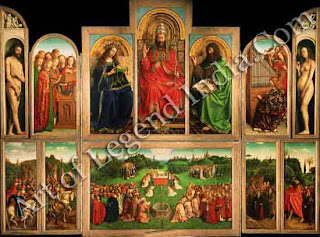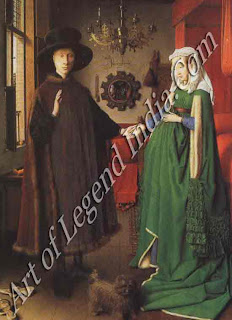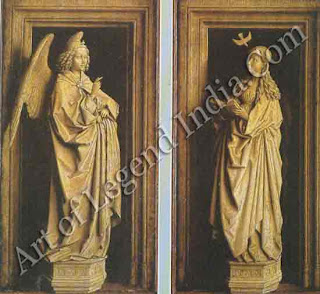Netherlandish Great Artist - Jan Van Eyck Painting Gallery
Posted by
Art Of Legend India [dot] Com
On
2:47 AM
All of Jan van Eyck’s
dated paintings are from the last decade of his life, when he was complete
master of the new oil-painting technique. Subsequent painters have developed
other aspects of the rich potential of oil, but no-one has ever surpassed Jan's
skill in the minute rendition of texture or the creation of glowing effects of
colour. The Ghent Altarpiece, with its countless figures, its beautiful
landscape and townscape backgrounds, and its exquisite still-life details, is
like I a manifesto of the possibilities of oil paint.
Van Eyck’s other
paintings are either religious paintings or’ portraits. Sometimes he combined
the two, as in The Madonna with Chancellor Rolin and The Madonna with Canon van
der Paele, and his most famous portrait The Amolfini Wedding has religious P
overtones in its symbolic references to the sanctity of marriage. His
individual portraits, such as Cardinal Albergati and Baudouin de Lannoy, show
his matchless ability to combine unrelenting physical scrutiny with a feeling
for the sitter’ s inner life.
This portrait has an inscription in Greek
characters reading Timotheos’, the name of a famous musician of antiquity. This
has led to speculation that the sitter was a musician, perhaps Gilles Binchois, one of
the leading Flemish composers of the period and like Jan van Eyck a member of Philip the Good’s court.
Giovanni Amolfini was a merchant from Lucca in Italy who settled in Bruges in 1420. His wife, Giovanna Cenami, was also from Lucca. This painting was almost certainly commissioned as a document of their wedding; varioussymbolic details (such as the dog, representing fidelity) attest to this, and it has an appropriate solemn dignity.
Nicolas Rolin, who is shown praying in front of
the Virgin and Child, was Chancellor of Burgundy and Brabant. The three arches
are probably intended to symbolize the Trinity (Father, Son and Holy Ghost); through them is seen a breathtaking landscape that shows Van Eyck's mastery of space and atmosphere.
These two panels, painted in grisaille (shades
of grey) may originally have been the outer wings of an altarpiece, but it is
possible that they always formed a diptych (a pair of pictures hinged down the middle). They are
remarkable pieces of illusionistic skill; the figures, which are like miniature
statues, appear to stand in front of the frames (painted, not real) and they cast delicately observed reflections on the polished background.
This painting is also known as the Lucca
Madonna, as it was once owned by the Duke of Lucca. It is one of Van Eyck‘s
most tender and intimate works, but it also has great dignity. As with so many of Van Eyck’s
paintings, the beautifully observed details can often be symbolically
interpreted; the four lions on the Virgin's splendid canopied throne, for example, make reference to those on
the throne of Solomon, wlzere they symbolized royal power.
Writer - Marshall Cavendish
Subscribe to:
Post Comments (Atom)
















0 Response to "Netherlandish Great Artist - Jan Van Eyck Painting Gallery"
Post a Comment